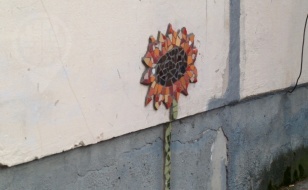
A.K.: Russian Aesthetic Education Centre later received the name of Mstislav Dobuzhinsky.
*A.K.*: Russian Aesthetic Education Centre later received the name of Mstislav Dobuzhinsky. It is still operating in V. Krėvės prospect, not far from the shopping centre used to be called Pasimatymas. I guess most of its visitors back then were children from the neighboring Russian school No. 20, even though later I attended the Lithuanian Pilėnai school. Probably it was my father’s initiative for me to attend all these extracurricular activities and have someone to practice my native language with, yet for me it has been (and I hope that it still remains) an exceptional place of artistic education, even though when I look back at this building, sad thoughts come to my mind. This place is like an island among the gray multi-storey buildings of Dainava, where people would create things, while we talked with teachers and fellow students in Russian.
Read more1 photographPovilas (first to the right) and Vandas (second to the left), Tarnauskas, restaurant "Versalis" shareholders, festive visit to Nemunas.
1 photograph Povilas (first to the right) and Vandas (second to the left), Tarnauskas, restaurant "Versalis" shareholders, festive visit to Nemunas. 4th decade. From the family archive of Ludza Riaukienė.
Read more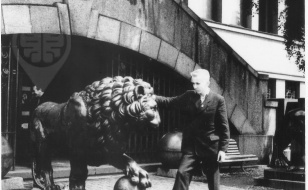
Jonas: “At the beginning of July 1962 and after graduating the 1st High School of Ukmergė (now the High School of Jonas Basanavičius), My classmate Vytautas Juknys and I, Jonas Navikas, arrived at Kaunas for the first time (!).
*Jonas*: “At the beginning of July 1962 and after graduating the 1st High School of Ukmergė (now the High School of Jonas Basanavičius), My classmate Vytautas Juknys and I, Jonas Navikas, arrived at Kaunas for the first time (!). After submitting our documents to the graduate admissions committee at the Central Office of Kaunas Polytechnic Institute (KPI) to enroll in the programme of radio engineering at the Faculty of Electrical Engineering, we reached a beautifully-shaped building on the other side of K. Donelaičio Street, which was then the History Museum. After looking around for some time, we noticed that individuals or groups usually take photos next to the lions. Having a photo camera at our disposal, we took photos of one another unaware of the fact that this place symbolizes the city of Kaunas. After coming back from Kaunas, you could show it with pride as a proof that you have visited Kaunas... These were the hot topics back then, when television was only making its first steps in Lithuania, and sightseeing tours were popular among both adults and school students. It is difficult to compare with contemporary technologies that have entered our daily lives...
Read moreGreta: If someone asked which place of student life is the dearest to me, I would say that it's Artists' House.
*Greta: *If someone asked which place of student life is the dearest to me, I would say that it's Artists' House. To be more precise, its café. When it ceased to exist, I felt like a child that grew up, came back to parents and found its room rented or turned into a storage space. Trauma...
Read more
Neringa: Yesterday, while driving from Vilnius to Kaunas, I saw the “new” sign of the city of Kaunas and realized that the old sign was a really special place.
*Neringa:* Yesterday, while driving from Vilnius to Kaunas, I saw the “new” sign of the city of Kaunas and realized that the old sign was a really special place. We would stop next to it every time we came back from Vilnius, even if relatives from America came to visit us. This was the first stop after Vilnius Airport, where we would all take photos with guests we haven't seen for a long time (or saw for the very first time). Even though the sign was a relict of the Soviet times, but compared to the “new” one, it had certain image and uniqueness to it. From my childhood, I remember those steps up to the sign and the red brightness of its background, that would contrast to the light blue summer sky. In this picture, it's me, my mother, and guests from America: Debbie and Ramutė in 1993. (2014)
Read more
Dobrė: “The action was held in November 1941: at 6 pm we were lined up.
*Dobrė*: “The action was held in November 1941: at 6 pm we were lined up. Our line, where my aunt, my grandmother and I were standing, was checked only after dark. At the time, I was ill, covered in boils, and for that reason I looked very tired, and my grandmother as well. Only my aunt was able to work. A Jew officer came to us, he was a friend of my father, which is why he let us go to the „good side” and we were not condemned to die. Everyone was amazed; it was a gift from God to us.”
Read more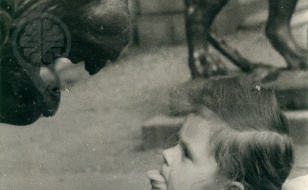
Rimantas: “This photo of my daughter Edita is taken in 1963, when she was 3.5-years-old.
*Rimantas*: “This photo of my daughter Edita is taken in 1963, when she was 3.5-years-old. I liked taking photos since my very childhood, we used to visit the garden in front of the Museum of War quite often, and this was where I captured her photo teasing the lions. I was working in a special scientific workshop, where various architectural and historic monuments were restored. Among many preserved architectural monuments in Lithuania, I also contributed to the repair of facades and interior of M. K. Čiurlionis National Art Museum and Museum of War. Your initiative inspired me to browse old photo archives. While looking for this photo, I looked through photos and slides featuring the construction of the Open-Air Museum of Lithuania, restoration of the Town Hall and Town Hall (Rotušės) Square, as well as reconstruction of The House of Perkūnas, the spire of Vytautas Magnus Church and many other monuments. Thus, I immersed into memories...” (2018)
Read more
Street, yard, house. I still remember where a turn should be taken in order to find myself next to the nine-store house, which was my most favourite place in my childhood.
Street, yard, house. I still remember where a turn should be taken in order to find myself next to the nine-store house, which was my most favourite place in my childhood.
Read more
Tadas Ivanauskas High School
Tadas Ivanauskas High School
Read more
Lili Kristina Vaičekauskaitė-Čepauskienė: If someone is collecting historical material, there is an interesting episode.
*Lili Kristina Vaičekauskaitė-Čepauskienė:* If someone is collecting historical material, there is an interesting episode. Photo (see photo No. 2) pictures mother of the Lithuanian partisan Kazys Veverskis (pseudonym Senis). Our family became acquainted with her under very interesting circumstances. This one time, my mommy went to the post office to run some errand and found a crying woman there. She came to send a parcel to her relatives imprisoned in Siberia, but she could not write their address. Then my mother brought her home to Vasario 16-osios Street, and my father packed everything nicely, wrote down the address and posted it for her. And this acquaintance was the one that lasted. I remember this woman visiting us for many years in relation to this matter. I called this woman my granny Veverskienė. (2014)
Read more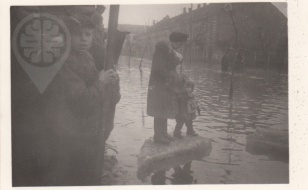
Lili Kristina Vaičekauskaitė-Čepauskienė: The flood of 1946 in Kaunas was a very strong one.
*Lili Kristina Vaičekauskaitė-Čepauskienė:* The flood of 1946 in Kaunas was a very strong one. The picture shows my mother and me on an ice flow at the corner of Vasario 16-osios and K. Donelaičio streets. After that year, there were no more floods like that.
Read more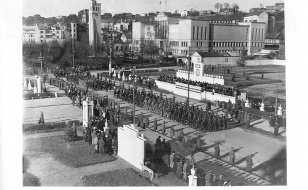
Alvydas Vaitkevičius: I found this picture at booksellers next to Merkurijus without any inscriptions or signs...
*Alvydas Vaitkevičius: *I found this picture at booksellers next to Merkurijus without any inscriptions or signs...
Read moreSITES OF MEMORY
1 Projects 114 12 Routes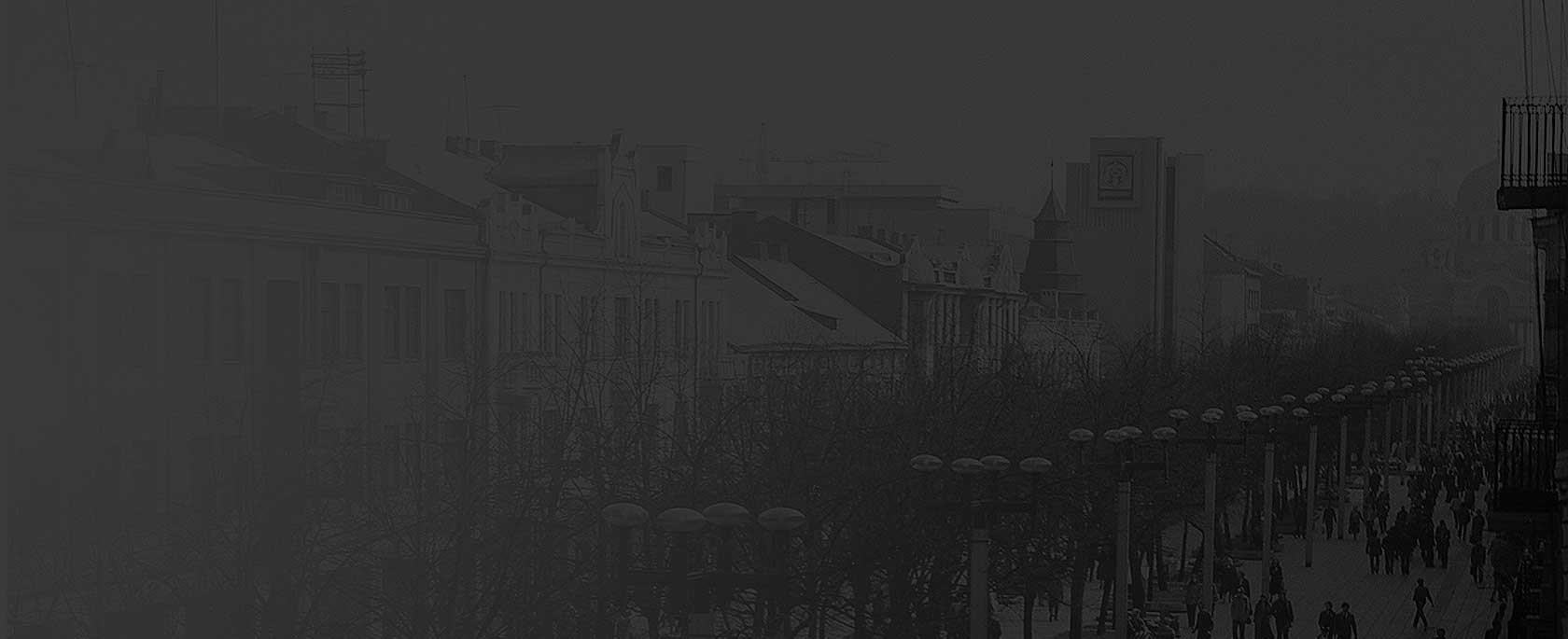
Our memory is framed by spatial reference points: places, sites, buildings, and streets give us our bearings and enable us to anchor and order our memories. So, the material alteration of these places can lead to the substantial modification of our memories, and even their disappearance.Post your memory here